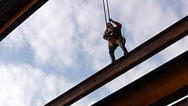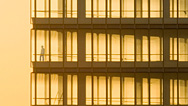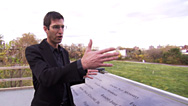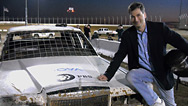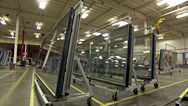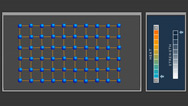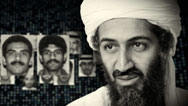
Ground Zero Supertower
Engineers race to complete 1 World Trade Center as they grapple with the final challenges. Airing September 11, 2013 at 9 pm on PBS Aired September 11, 2013 on PBS
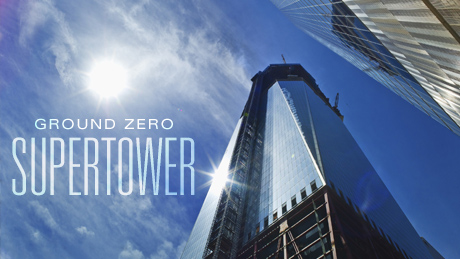
Program Description
Transcript
Ground Zero Supertower
PBS Airdate: September 11, 2013
NARRATOR: An icon rises in the New York City skyline: 1 World Trade Center, 104 stories tall, reaching a symbolic 1,776 feet. It's been an epic journey, filled with troubling problems and innovative solutions.
STEVEN PLATE (Director, World Trade Center Construction, Port Authority of New York & New Jersey): We're really at the cutting edge on everything at this site.
T.J. GOTTESDIENER (Managing Partner, Skidmore, Owings & Merrill, LLP): This building is not a skyscraper; it's taller than a skyscraper. This is in another league.
NARRATOR: For architect David Childs, it's the challenge of a lifetime.
DAVID CHILDS (Architect, Skidmore, Owings & Merrill, LLP): We knew this building would have all eyes on it, and it needed new technical advances that would set the path for other buildings in the future.
NARRATOR: Next door is the 9/11 Memorial to honor those who died in the worst terrorist attack in American history.
LOU MENDES (Vice President of Construction, National September 11 Memorial & Museum): Future generations need to understand what took place at this site.
NARRATOR: And 70 feet below ground is the 9/11 Museum.
PAULA BERRY (Board Member, National September 11 Memorial & Museum): The role that this museum plays is really to punctuate what that day means for you.
NARRATOR: After more than a decade, the building of 1 World Trade Center is almost complete.
DAVID CHILDS: It is very important that we did rebuild. It gave us a chance to rebuild better.
JOE DANIELS (Chief Executive Officer and President, National September 11 Memorial & Museum): We have the D.N.A. of strivers—that's part of the American character—so there was this desire to rebuild tall again.
NARRATOR: It's the birth of an icon, but will it live up to its promise to be beautiful, safe and ahead of its time? Ground Zero Supertower, next on NOVA.
A beacon rises 104 stories up to the top of the tallest building in New York, perhaps the tallest building in the Western Hemisphere.
PAUL GOLDBERGER (Architecture Critic, The New Yorker): Going back into the sky is really important, because that was something that was taken away. And I think it's appropriate to put it back, to show that the life of the city goes on and is more powerful than the forces that attacked it.
NARRATOR: Its creators' hopes and dreams are riding on it being not only the highest, but the safest, most innovative and beautiful skyscraper in America.
DAVID CHILDS: I feel a great sense of accomplishment. This building is a strong visual image of our resilience, coming back after this terrible tragedy.
NARRATOR: The tragedy was the worst terrorist attack in American history, September 11th, 2001, causing unimaginable destruction, killing almost 3,000 people. Out of the ashes, one of the world's most innovative skyscrapers is rising. Soon, its beacon will illuminate the New York City skyline.
JOHN GEBBIE (Barbizon Lighting Company): You're going to look up there, and you're going to, you're going to identify with 9/11, with 1 World Trade Center, as a result of this beacon of light.
T.J. GOTTESDIENER: I know for me, wherever I am and I can see that light, I'll know that as Americans, as architects, as New Yorkers, that we have resiliency. We triumph, we come back. We built this. We're reaching for the stars.
NARRATOR: It has taken over a decade to lift this beacon a symbolic 1,776 feet, to the top of 1 World Trade Center. But it is just one of the many challenges architects and engineers have faced on this 16-acre construction site, known as Ground Zero.
Today, it is bustling with activity, from hundreds of feet in the air to seven stories below the ground.
BILL BARONI (Deputy Executive Director, Port Authority of New York & New Jersey): Twelve years ago, people thought nothing would ever happen here; four years ago, people thought nothing was happening here; and now, people know this site is back.
NARRATOR: When complete, the site will include a train station to rival Grand Central, six new towers, and, at its heart, the 9/11 Museum & Memorial, built in the footprints of the Twin Towers of the World Trade Center that once stood here and were destroyed in the attack.
BILL BARONI: We owe it to those that didn't get to come home, who didn't coach another Little League game, didn't get to see their kid get married. That's why we're doing it.
NARRATOR: And so, as the Port Authority of New York & New Jersey build this supertower, safety is paramount, and a new approach is required.
Back in their day, the Twin Towers were considered state-of-the-art. They employed a unique steel structure that allowed for wide open floor spaces, where up to 40,000 people went to work each day. But decades later, these marvels of engineering proved vulnerable in a way no one had foreseen.
Architect David Childs watched the events of 9/11 unfold from his office in downtown Manhattan, where, at 8:46 a.m., the North Tower was struck by an airplane. Then the South Tower is hit. Both buildings are in flames.
DAVID CHILDS: I remember walking up to a window, and a young man turned to me, with tears coming down his face. And he said, "Will they fall down?" And I said, "No," right away, because I knew that if they hadn't been knocked over, they wouldn't fall down. The fire would be put out. Never has a steel-structured building, in the history of steel-structured buildings, ever fallen down for reasons of fire.
NARRATOR: Never before had a steel structure, under fire, absorbed the loss of such massive columns from an impact. At 1,800 degrees Fahrenheit, it's hot enough to weaken the steel structure. The North Tower stands for an hour and 42 minutes, the South Tower, for only 56. Finally, the steel gives way to the heat, the floors start to sag, the perimeter steel columns buckle. The Twin Towers do the unthinkable: they collapse.
Nearly 3,000 people die.
Several months after the attack, David Childs starts to think about designing a new tower at Ground Zero. It is the challenge of a lifetime to come up with a building strong enough and safe enough to be built on this site.
DAVID CHILDS: Safety has always been a measure of how buildings are built. Go to Florence; some great buildings of Florence are all about defense. Great pieces of rusticated stone, metal bars across the windows, and yet you look at those buildings and you think proportion and texture and shade and the interaction of the different materials. You don't think about safety, today.
NARRATOR: Childs hopes to achieve the same balance, through innovation.
DAVID CHILDS: We needed to investigate and invent new ways to show how buildings could be built in the future. So this building must look forward, in terms of new technology, new inventions. How do we make the ideal building of the future look forward?
NARRATOR: As David Childs looks for ways to answer this question, Ground Zero is in ruins. Rescue workers are desperately searching through the rubble for the remains of those who were still unaccounted for, when, beneath more than a million tons of debris, engineers discover another disaster, waiting to happen. The site is at risk of being inundated by the Hudson River, only a few hundred feet away.
T.J. GOTTESDIENER: Many people aren't aware that this site, at one point, was under water. It was, it's landfill.
Over time, docks and wharves and landfill slowly increased the tip of lower Manhattan. What this means is that the site that was occupied by the World Trade Center is, literally, in water.NARRATOR: To build the world's tallest towers on land like this, engineers had to find a way to keep the river out. They came up with an ingenious idea.
LOU MENDES: This entire complex was built inside what we call a "slurry wall."
NARRATOR: The slurry wall encircled the World Trade Center complex like an enormous bathtub.
JOE DANIELS: A bathtub where the W.T.C. site was built within. It essentially kept out the Hudson River. It kept out all the wet soil surrounding the site.
NARRATOR: The slurry wall was made up of over 100 panels, each one 22 feet wide and seven stories deep, going all the way down to two feet below bedrock. Each section was excavated and filled with a gluey clay mixture called slurry, which keeps silty soil and water from getting in.
Next, a 70-foot long steel frame, weighing 22 tons, was lowered into the slurry-filled panel. Concrete was slowly pumped into the panel and the slurry, which is much lighter, rose to the surface and was pumped out. When the concrete hardened, they repeated the process, over and over again, forming a massive underground wall.
LOU MENDES: Once the wall was built, they proceed with the installation of tiebacks. These tiebacks actually hold the wall to the rock.
NARRATOR: Tiebacks are long steel rods that go all the way down to bedrock to support the wall.
LOU MENDES: They become diagonal structural elements that pull the wall to the rock.
T.J. GOTTESDIENER: So the whole site is basically a bathtub, pushing back the waters of the Hudson.
NARRATOR: After 9/11, it looked as though this enormous bathtub might have been weakened and could collapse.
T.J. GOTTESDIENER: There was real concern that this wall was going to be breached.
WORKER: These walls are coming in. They moved in around six inches. These walls hold back the river, so if these walls cave in, this place is going to get flooded out by the river.
JOE DANIELS: A disaster that was already incalculable, in terms of the human loss and the loss to just lower Manhattan and New York City, would have gotten that much worse.
NARRATOR: Securing the slurry wall became a top priority. Soon, engineers discovered that the 1.8 million tons of debris filling the bathtub were actually preventing it from collapsing.
LOU MENDES: The debris was actually acting as a barrier to keep the wall in place. That's why we couldn't just remove all the debris. We have to remove it in lifts, in pieces. And we did this like a mining operation around the entire pit. And every elevation of debris we removed, we had to install new tiebacks. Once the new tiebacks were installed, we felt more comfortable that the wall was now secured properly, was structurally sound.
NARRATOR: A new liner wall was built, right in front of the original. But a section of the old one has been left exposed, as a reminder of what happened here.
JOE DANIELS: The very last piece of steel to be removed from the site, the last column, was removed on May 30th of 2002, and it signified the end of the recovery period.
NARRATOR: The recovery period is over, the slurry wall secured, nearly 2,000,000 tons of debris removed. Now the site is empty. There is a gaping hole in the New York City skyline, and no one can agree on how to fill it.
GEORGE PATAKI (Governor of New York State, 1995–2006): Everyone had a different idea and a different vision of what should happen there. Some important figures didn't want any memorial, wanted the whole thing redeveloped. Others said, "You can't develop anything down there. It all has to be preserved." So pulling everything together was, was not an easy task.
MICHAEL BLOOMBERG (Mayor of New York City, 2001–2013): It was certainly frustrating as to how long it took, although, remember, Central Park was probably 20 years late and six times over budget, and nobody remembers that. The question is where are you, not how you got here.
NARRATOR: David Childs, along with partner T.J. Gottesdiener, and a team of architects and engineers are in the thick of it, rethinking strength and safety from the inside out, starting at the "core."The core of a skyscraper is a backbone that runs up the center. It provides structural support and strength. Childs' design for the core of this super-tower will use one of the strongest, most fire resistant materials around: concrete.
But this isn't just any concrete, this concrete needs to be so strong, it means going back to the lab to develop it.
CAS BOGNACKI (Engineer, Port Authority of New York & New Jersey): This is a concrete specimen that will be used for Tower One at the World Trade Center. If you could set this cylinder and put a platform on it, you can accommodate a thousand Americans standing on this cylinder, you know, normal people, 175 pounds in weight. A thousand people can be supported by this four-inch diameter cylinder.
NARRATOR: Concrete is made of sand, stone and binding agents, like lime or cement, that, when water is added, hold the mixture together. But the recipe can be revised by using less water, replacing it, instead, with chemicals that keep the concrete moist without reducing its strength.
CAS BOGNACKI: Water makes this concrete move in place, but you can't have too much water 'cause when you have too much water, the strength goes down.
NARRATOR: The goal: to make concrete that can withstand loads of up to 14,000 pounds per square inch. Normal concrete is about 4,000 P.S.I. Even the Hoover Dam is no more than 7,500.
But strong concrete has its own challenges. It hardens quickly, so it's a race against time to get it into place before it sets. Driver Eric Szemple has only 90 minutes to get the job done.
ERIC SZEMPLE (Driver): Concrete, it's a perishable item. We have, like, an hour and a half to get the load off.
NARRATOR: By 2006, this super-strong concrete makes its way to Ground Zero, where construction has finally started. Crews have less than an hour to pump it through an elaborate system of hoses, where it is poured into a mold and secured with steel bars, called rebar, that give the concrete something to latch onto. The hope, for this reinforced concrete is that it will withstand unforeseen challenges in the future.
SAL MERLINO (Construction Worker): It's strong. That's why I call it "liquid steel."
NARRATOR: When finished, 1 World Trade Center will contain almost 500,000 tons of this liquid steel, much of it in its core, which has walls up to six feet thick.
DAVID CHILDS: The outside of the core, this whole center spine of the building is of concrete.
NARRATOR: The cores in the Twin Towers were compromised on 9/11, because they were made of steel, wrapped in thin Sheetrock™.
DAVID CHILDS: Where the planes hit, that Sheetrock was not strong enough to take that punching shear.
NARRATOR: At the point of impact, the stairs were destroyed, leaving nearly 2,000 people trapped above, with no escape. That's why it's critical for 1 World Trade Center to have a super-strong concrete core, well beyond existing building codes.
Inside, the core protects a total of 73 elevators. Some can travel 23 miles an hour, making them the fastest elevators in the Western Hemisphere. The core also has staircases that are extra wide and pressurized to keep smoke out.
DAVID CHILDS: When a door is opened, that pressure goes out, keeping the smoke away from it. And that's a very effective thing. Smoke is the real killer.
NARRATOR: One World Trade Center's concrete core is designed to avoid the tragedy of 9/11, where two-thirds of the victims died because they couldn't get out of the building.
And nothing will remind us of that more than the 9/11 Memorial & Museum, being built next door. The entrance of the museum will be at ground level, but the heart of it is being built 70 feet below the surface.
STEVEN M. DAVIS (Partner, Davis Brody Bond): The overall museum is about 120,000 square feet. Except for the entry pavilion, it's underground. At bedrock it's about 95,000 square feet.
NARRATOR: Here, parts of the Twin Towers' foundation are carefully preserved, like a section of the original slurry wall and these huge girders that supported the floors above.
RONALDO VEGA (Director of Design, 9/11 Memorial): These are the original box beams; these are the original structure that held up the columns that held up the North Tower at the north base. I consider them almost like a dinosaur skeleton: you look at it and wonder what was.
JOE DANIELS: The museum is an archaeological space as much as it is a museum. So, when you go to bedrock, and you see the very footprints where the towers sprung to life, it is sacred bedrock. These buildings soared more than 1,300 feet into the sky and defined the New York City skyline. This notion of authenticity of place, Steven, it was super important to us.
RONALDO VEGA: You're standing on bedrock. This is as low as the World Trade Centers were. So, this is pretty magical right now. It's becoming more of a construction site and less, less of a disaster zone.
NARRATOR: The museum will house artifacts that have been stored for over a decade, in an old hangar, at New York's J.F.K. airport.
ALICE GREENWALD (Director, National September 11 Memorial & Museum): Engineers and architects who went through the debris had the charge of identifying remnant pieces of the building that could help scientists better understand what happened. They also were looking for things that might someday help reconstruct the event.
NARRATOR: In twisted steel and broken beams, the full scale of what happened on 9/11 can be witnessed.
ALICE GREENWALD: This material filled an 80,000-square-foot airline hangar. What was in that hangar represented less than one percent of what was at the site, and it filled it to capacity. So just walking into that hangar you had a sense of the enormity of what had happened.
NARRATOR: Some of these artifacts are so large they are brought on-site before the museum is finished, so it can be built around them, like these seven story tridents. These enormous pieces of steel, which weigh 50 tons each, formed the distinctive Gothic arch motif at the base of the Twin Towers. So many tridents survived the attack, their silhouette has become a symbol of strength. In 2010, two were brought on-site and set in place.
ALICE GREENWALD: The two we chose were, in fact, side by side on the North Tower. So you have a twin presentation; they embody a memory of the twin-ness of the Twin Towers.
NARRATOR: Over the next few years, the entrance of the museum will be built around them. Almost 1,000 artifacts from September 11th will be on display at the museum.
This fire truck, wrapped in plastic, is lowered, through a hole in the roof, 70 feet down. It's from the fire department's Ladder Company 3, which lost 11 of its own while helping evacuate others.
Each artifact tells a story, like this mangled piece of steel, called M2, that was located where the first plane, American Flight 11, from Boston, struck the North Tower. It is a chilling reminder of the moment the attack started.
Now, it is hoisted up and set in place.
LOU MENDES: Future generations need to understand what took place down here. When they see a piece of steel bent and twisted like that, they can now begin to understand the amount of destruction, the amount of sadness that came upon this site.
NARRATOR: Next door, at 1 World Trade Center, a one-of-a-kind structure is taking shape. Twenty stories high, the podium base is designed to be strong enough to survive a massive truck bomb, and unless the base of the building is super-strong, it could also be hard to attract renters.
The podium has thick concrete walls that are reinforced with large steel columns. Not only is it strong, it will look strong enough to be a deterrent.
DAVID CHILDS: One of the things that I've learned about safety is the appearance of safetyâ¦if somebody looks at a building, and says, "Boy, that looks pretty flimsy," they are interested in it. If it looks tremendously strong you say, "Well, let's go pick on somebody else."
NARRATOR: But there's a cost to this approach. David Childs does not want to create a fortress. In an attempt to make the podium more inviting, he designs soaring entryways. Behind them, giant concrete blast walls protect the lobby, but Italian marble will hide their true purpose. And large openings will allow sunlight to stream in.
DAVID CHILDS: Because of the nature of the destruction that was here before, you don't want to give the impression that this is a place of refuge and of fear. You want there to be a sense of openness to it. This building needs to appear open.
NARRATOR: So he decides to cover the podium with a kind of glass that reflects light like a prism. The glass will have to be cut in a way that could compromise its strength. It's a unique challenge, but not the only one. Creating panels of glass big enough to start with is also tricky.
JEFF YIGDALL (Engineer, PPG Industries): This glass is one-inch-thick glass, 130 inches wide and 159 inches long. Each individual piece of glass is 1,800 pounds—almost a ton of glass in one, single piece.
NARRATOR:To create these one-of-a-kind panels, they start the old fashioned way: take sand, combine it with other ingredients, like lime and baking soda, and put it in a furnace, at temperatures nearly 3,000 degrees. The intense heat turns the mix into liquid, which is then poured onto molten tin. The glass appears as a red line, floating on top.
On rollers on a line almost a quarter of a mile long, the glass cools and strengthens, but if conditions aren't perfect, neither are the panels.
JEFF YIGDALL: And you can see here, that glass in the background just going down. So, even though we look at this as a momentary disaster in our process, that told us what we need to do to make the correction in an engineering sense.
NARRATOR: At the end, it's cut into those large panels.
Next, these enormous panes of glass are placed on ships and sent halfway across the world, to China, where they designed special machines to cut grooves into the glass. But will it hold up? For such a high tech product the test is simple and revealing.
ALAIN LAPIERRE (Glass Company Worker): Three, two, one.
NARRATOR: It's no surprise that it breaks, but it's designed to stick together, like safety glass.
ALAIN LAPIERRE: Three, two, one.
NARRATOR: Instead it shatters into dangerous shards.
ALAIN LAPIERRE: As you can see, the debris are pretty big. Something like that would fall on your head, that would not be pleasant. This is why we do these kind of tests.
NARRATOR: When the results reach New York, the news is heartbreaking. This building is David Childs' legacy. He needs to find a new solution for the podium glass that will be both safe and beautiful.
Above the podium, Childs is getting much better results. One World Trade Center is rising, a floor a week. Inside, there is a steady rhythm of work: build out the floors with concrete, spray with fireproofing, lay elevator tracks in the cores.
PHIL DUCATELLI (Elevator Construction Crew Member): â¦all the way, to the very top.
NARRATOR: As the core rises, on the outside, 1 World Trade Center is starting to take on its distinctive shape. The podium is a square, about the size of the original towers. At the 20th floor; the corners taper in; a square becomes an octagon; four sides become eight interlocking triangles; finally, at the top, it resolves in a square once again.
DAVID CHILDS: The profile, as you look from the Memorial, is identical to the old, but, as you walk around it, you see the corners tapering in. It's a new, modern building, but it has a memory of what was lost.
NARRATOR: To achieve this subtle shape shift, Childs turns to steel: 45,000 tons of it.
DAVID CHILDS: Steel is relatively light, it's flexible. You can do all sorts of things with it. It's supple. It's a wonderful material.
NARRATOR: Almost a quarter of it, 10,000 tons, starts here: Coatesville, Pennsylvania.
One World Trade Center is designed to be a Certified Green building. Steel contributes to that, because much of it comes from recycled materials like old refrigerators, cars, even toasters. All melted down into liquid. Then it's poured and molded into giant sheets.
The sheets are carefully cut, welded and shaped to make pieces that fit in a specific place in the building. Some of the largest are called "nodes." They can be as large as 60 tons and stand three stories high.
Nodes are giant joints that hold multiple pieces of steel together. They come in all shapes and sizes and make it possible for the building to shift form, from four sides into eight. And they also help re-distribute the weight as the building rises.
Back at the site, a critical node is ready to be hoisted into place.
PETER JACOBS (One World Trade Center Raising Gang): Get it up there closer to the rig.
NARRATOR: Working with steel this big takes experience.
Peter Jacobs is a member of the Mohawk Nation, famed for their work on skyscrapers and bridges for over a century. He is a fifth-generation ironworker, a member of an elite group called "the raising gang."
Their work starts at the base of the building, where they move giant crane hooks, called chokers, into place. Two cranes lift the massive 40-foot-high node hundreds of feet up, as the raising gang guides it into place.
PETER JACOBS: It's a dangerous job, connecting, very. It's the most dangerous job out of all of them. If you ain't got the heart...that's the whole key, right in there.
NARRATOR:The work of the raising gang hasn't changed since steel-frame construction began over a century ago. Neither has the next gang to take possession of the massive node, the bolting gang; their job: to mercilessly pound and bolt the node into place.
STEELWORKER 1 (One World Trade Center Bolting Gang): If things are off by one or two or three inches, we bring out the big boy. Show them the big boy.
STEELWORKER 2 (One World Trade Center Bolting Gang): The big boy's here.
STEELWORKER 1: And that pulls the entire building into plumb.
NARRATOR: It's the "plumb-up gang" that makes sure every column is perfectly plumb, perfectly vertical.
STEELWORKER 3 (One World Trade Center Bolting Gang): It's a game of less than inches; it's a game of quarter inches.
NARRATOR: The plumbness of a building is critical.
STEELWORKER 3: Our tolerance is probably one inch on the column, and we try and keep everything within a half inch of where it needs to go. So it's quarter inches, and eighths and sixteenths; it's not inches.
NARRATOR: The slightest mistake and the building will tilt.
Finally, the welding gang completes the join.
STEELWORKER 3: When you first start working, walking the steel, you feel like, "All right, look around you. Look how high up I am." But after a while, you're focused on your work. You really don't think too much that, oh, you are 7-, 800 feet in the air.
NARRATOR: A steelworker's nerve leads the way up a super skyscraper. Story after story, the steel goes up. The concrete core, which gives 1 World Trade Center its strength, follows several stories behind.
Until the core catches up, the steel frame needs stability.
To solve this problem, Larry Davis, at DCM Erectors, comes up with a novel idea.
LARRY DAVIS (President, DCM Erectors, Inc.): We saw this great big space, and we said, "Well, maybe we can put something in here."
NARRATOR: So Davis puts cargo containers between the steel beams and outfits them with tables and chairs where construction workers go on breaks.
He calls them hotels.
LARRY DAVIS: We built, like, a little city, where we have washrooms, work stations.
NARRATOR: Even a subway shop where crews go for lunch.
STEVE PLATE: To go to the top with some of the hoists took a substantial amount of time, especially with 1,200 workers, each and every day, moving around, throughout the building, up and down.
NARRATOR: With only a half hour for lunch and up to an hour's commute from the top of the building to the base, the hotels are a real time-saver for workers.
LARRY DAVIS: So that's our accommodation for the job, which works well, because of the height of the building.
NARRATOR: Another problem building high: equipment and tools can hurtle more than a thousand feet onto construction workers or pedestrians below. To prevent this from happening, Davis designed a fireproof steel-framed net that covers the exterior of the top floors of construction.
LARRY DAVIS: The cocoon system provides tremendous worker safety and prevents anything from coming off the building.
NARRATOR: The hotels, two cranes and the cocoon climb the super-skyscraper in unison.LARRY DAVIS: We can climb the cranes in two hours, all the hotels in four hours, and the cocoons climb in about six hours.
NARRATOR: As 1 World Trade Center makes its way into the New York City skyline, right below another extraordinary structure is taking shape: the 9/11 Memorial, the vision of architect Michael Arad.
This design calls for two pools, in the footprints of the original towers, surrounded by a forest of trees.
MICHAEL ARAD (Architect and Designer, 9/11 Memorial): It was an idea that was just in my head and then on a piece of trace paper. And then, eventually, I ended up building a small fountain on my rooftop.
NARRATOR: He calls it "Reflecting Absence."
PAUL GOLDBERGER: Using the footprints of the two towers as the starting point for the memorial is actually very powerful symbolism. Where there was presence, there is now absence; where there was solid, there is now void.
NARRATOR: Each pool is 30,000 square feet.
RONALDO VEGA: You could not imagine the scale of it, unless you're looking at it, right here.
NARRATOR: They are lined with granite from a quarry in Virginia. Almost 5,000 tiles must be laid in a specific order, so there is a continuous pattern to the grain.
RONALDO VEGA: Just look at that stone. If you could just imagine the lines not being there, it looks like one stone. Look at how that grain just flows. It's almost as though this stone, is a continuation of this stone. The adjacent piece looks like it belongs next to it.
NARRATOR: When the pools are complete, 52,000 gallons of water will cascade over the walls every minute, drop 30 feet, and disappear into a second, inner pool.MICHAEL ARAD: We didn't want to create a torrent. This is not about being behind Niagara Falls. It was always about creating something that is gentle yet persistent.
And then the question is, "How do you make that idea take shape?"
NARRATOR: The solution arrives on site. It's called a weir. Weirs are normally used to alter the flow of rivers to prevent flooding, but here, they need to move water into the shape of an architect's vision.
The weirs are there to push it outward just far enough to give it a gentle arc, to make it fall in a neat cascade.
Now in place, the weirs are ready to be tested. It's time to turn on the water.
Workers carefully watch, as water starts to flow through the system into the troughs by the side of the pool.
9/11 MEMORIAL WORKER: It's holding pretty good, so we're going to go ahead and let it go over.
Let's get it over the top right now.
9/11 MEMORIAL WORKER: Okay.
ALFREDO JIMENEZ (9/11 Memorial Worker): It's coming over there.
9/11 MEMORIAL WORKER: It's starting to go over here, too.
ALFREDO JIMENEZ: Yeah, yeah, that wall; the wind, the wind is doing it.
9/11 MEMORIAL WORKER: Oh, yeah, there it goes.
MICHAEL ARAD: It's beautiful. It's moving. I, um, am at a loss for words.
NARRATOR: But the hardest part is yet to come. In Dover, New Jersey, powerful water jets engrave the names of the 2,982 individuals whose lives were lost on 9/11.
The names are not listed alphabetically, but by the locations where individuals died: the South Tower, the North Tower, Flights 11, 93, 77, 175 and the Pentagon. First responders and those who died in the 1993 attacks are also grouped together.
PAULA BERRY: It, in essence, does tell the story of what happened, largely by the way in which the names are arranged. So, when you go, you will actually be able to sort of peel back and understand the story a little better.
JIM MORETTI (President, Service Metal): Fifty percent of the folks that are on the Memorial, no remains were found, and so this is going to be, for many families and many loved ones, the place that they will go on those special days, the birthdays, anniversaries. Unfortunately, this is their final resting place.
FRANK ANDOLINO (Service Metal): It's heartbreaking, really, to look at all these people and the pain them and their families endured. It's sad, it really is. But we've got to get a job done.
NARRATOR: As 152 bronze panels are carefully etched, hundreds of trees are being prepared to be taken to their new home: Ground Zero.
They originally come from the three places where people died: New York, Pennsylvania and the Washington, D.C. area. They will become part of an eight-acre forest on the memorial plaza. Beneath the plaza, a complex irrigation system has been devised to bring water and fertilizer to each and every tree.
But what makes this system truly advanced is the sensor technology embedded in the soil.
RONALDO VEGA: These trees have their own, their own computer chip in them. They have their own monitoring system for aeration and irrigation. I mean, each tree has its own little ecosystem, so we know how they, how they're doing. It's all high tech, real high tech, and yet when you look at it, it's just a beautiful little forest.
NARRATOR: Sixteen trees, weighing 18,000 pounds each are being hoisted and prepared to move.
RONALDO VEGA: It's a magical time today. There's nothing like planting a tree.
NARRATOR: The trees arrive at Ground Zero just in time for the Memorial to open, on 10th anniversary of 9/11.
SINGERS: "Oh, say, can you see, by the dawn's early lightâ¦"
JOE DANIELS: The memorial is a place of reflection and remembrance. And, really, there's something positive, in that, out of such tragedy, we were able to do something that is really beautiful. And for the families and friends of those who were lost, it is a place to remember the lives these individuals lived.
NARRATOR: One of those individuals, David Berry, was on the 93rd floor of the South Tower when it collapsed. Ever since, his wife, Paula, has dedicated herself to seeing the Memorial come to fruition.
PAULA BERRY: I find it really heartening to see all these tourists come, wrapped in ponchos, with their umbrellas, knowing full well they're coming to see it in the rain. This was, this was a disaster area, and then a construction site. But I think it's become a place of contemplation. People will take away the magnitude of the event and the loss.
NARRATOR: By the 10th anniversary, in 2011, the supertower had reached 80 stories, and huge panels of glass were starting to cover the exterior.
Over the next several years, these enormous panes of glass, called "the curtain wall," will make 1 World Trade impermeable to the elements of its surroundings, except for one: wind.
T.J. GOTTESDIENER: When you build buildings of this height, you now begin dealing with a whole new set of criteria. One of the things is the sway of the building, and that sway comes from wind, the wind pushing it back and forth.
NARRATOR: When wind hits a rectangular skyscraper it pushes against the flat surface and creates turbulence around the sides, and that causes the building to sway. But 1 World Trade Center's unique design means the wind is not a problem.
DAVID CHILDS: This building is tapered at the corners, so that, as the wind hits the top, it confuses the wind.
NARRATOR: Instead of hitting a broad, flat surface, the wind flows around the tapered corners in a more gentle way, and that reduces the turbulence and the sway. And there's another reason this supertower has so little movement.
T.J. GOTTESDIENER: The building has so much redundancy of structure and strength at the core of that center spine, with concrete supporting it, it naturally is a very, very stiff building.
NARRATOR: At its base, where its builders claim 1 World Trade Center is stronger than any skyscraper ever built, a solution has finally been found to the prismatic glass which shattered when put to the test.
T.J. GOTTESDIENER: This is a small sample of the glass. And it's literally three layers of glass laminated together, different qualities of glass and thickness for strength and rigidity. But what happens is you get this beautiful quality, beautiful opalescence to the glass.
NARRATOR: Over the next few months, thousands of panels of glass will cover the entire base of the building. But unlike the curtain wall above, they're not flat. In order to let air in and out of the mechanical systems behind them, the panels open up.
DAVID CHILDS: It's not just a skin. There's a depth to it. It gives you the opportunity of being something which is breathable and open and, in a way, welcoming.
NARRATOR: Although this podium glass was not David Childs' original vision, he knows that no project as complex and innovative as this can be completed without its trials.
DAVID CHILDS: At the end of the day, nobody will recognize all of those trials and difficulties of getting these things all to be solved in a simple building, but to have this building as a serene a form as possible was terribly important to me, as the designer.
NARRATOR: By the summer of 2013, the 9/11 Museum is also on its way to completion, scheduled to open in several months.
PAULA BERRY: Wow, this is so different from when I was here last. It really is beginning to look like a museum. And you can see how huge this space is; it is cavernous. This is an overlook, the first time you get to see the slurry walls, and it always sends chills up my spine. This is, this is, this, to me, is, resilience. This is resilience.
This is the survivor's staircase. Many people within the building used these stairs to get out. They represent those people who were saved.
JOE DANIELS: When people come to this museum and they see the worst of humanity in the attacks that took place, they're also going to see the best of humanity. The first responder vehicles we have in this museum, they're so powerful, because they tell the story of the sacrifice and selflessness of so many. For our children, for people around the world, it's a comforting thing.
NARRATOR: Just before the winter descends on the New York harbor, a barge makes its way down the Hudson River, past the Statue of Liberty. It is carrying precious cargo: the first nine sections of the 1 World Trade Center spire.
It has taken a month for them to make their way from Quebec, to their final destination: Ground Zero.
The next morning, the heaviest piece, the 67-ton base is lifted to the roof: 1,368 feet.
WORKER: It's nice to be a part of it. Finally, we're reaching it, and it's symbolic, and everybody knows that, so I'm excited and proud to be here.
NARRATOR: Over the next several months, the remaining 15 sections of spire are lifted to the top of the supertower and assembled.
WORKER: It just means the world. It's a major step forward. It just puts everything back to where it should be.
NARRATOR: And finally, the last two sections of the spire, including the beacon, are lifted to reach a symbolic 1,776 feet. For the thousands of workers who built this tower, it's a moment to savor.
PATRICK J. FOYE (Executive Director, Port Authority of New York & New Jersey): When it was bolted into place, the construction workers and everyone on the roof broke into cheers and applause. It was a breathtaking moment.
NARRATOR: On the 12th anniversary of 9/11, construction at 1 World Trade Center is almost finished. Ground Zero is nearing completion. The end is in sight.
PETER JACOBS: Yeah, it's going to be a hell of a landmark, you know? You can go back, point it out to your kids or your grandkids one day and say, "I helped build that building," you know?
NARRATOR: Already, people are visiting here from all over the world. Soon they will work here. Life has returned to Ground Zero.
RONALDO VEGA: People will know, intuitively, where they are when they come here. They'll know what was here. They'll know the loss that was here, and, yes, they'll still feel that loss, but it's a place of healing.
NARRATOR: In years to come, this sacred ground will take on new meaning that we can't now foresee, but the way Ground Zero has been designed and built makes one thing certain: what happened here will never be forgotten.
Broadcast Credits
- PRODUCED AND DIRECTED BY
- Terri Randall
- TELESCRIPT BY
- Terri Randall
- STORY BY
- Timothy Smith & David Smith
- EDITORS
- Jedd Ehrmann
Kris Liem - ASSOCIATE PRODUCER
- Amital Isaacs
- CINEMATOGRAPHERS
- Joseph Friedman
Daniel Traub - ADDITIONAL CAMERA
- John Denise
Michael Dombrowski - SOUND RECORDISTS
- Alex Marshall
Luis Granados - ORIGINAL MUSIC BY
- Justin Melland
- MUSIC
- ScoreKeepers Music
- NARRATOR
- Jay O. Sanders
- ANIMATION
- Brian Edgerton
- ONLINE EDITOR
- Evan Anthony
- AUDIO MIX
- Bill Cavanaugh
- ASSOCIATE RESEARCHER
- Shraddha Chakradhar
Producers gratefully acknowledge the cooperation of the Port Authority of New York and New Jersey
- ARCHIVAL MATERIAL
- 9/11 Memorial & Squared Design Lab
Associated Press
CNN Image Source
Corbis
FEMA News Photo
Getty Images
Great Projects Film Company
Hunter Baker
Library of Congress
Pond5 Stock Footage
ITN Source
Shutterstock
Skidmore, Owings, & Merrill
WGBH - SPECIAL THANKS
- Anthony Hayes
Rudolph King
Elizabeth Kubany
Lynn Rasic
Christey Robinson
Francis Barry
Marc Becker
Michael Frazier
Alan Hicks
Michael Hurley
Richard Kielar
Amanda Konstam
Catherine Yrissari
Portions of this program were originally seen in NOVA's ENGINEERING GROUND ZERO
- EXECUTIVE PRODUCERS
- Timothy Smith
Anthony Cicatiello - DIRECTED BY
- David Shadrack Smith
- CO-PRODUCERS
- Tennaly Fortier
Jeff Seelbach - ENGINEERING GROUND ZERO
- EDITED BY
- Jeremy Siefer
- CINEMATOGRAPHER
- David Shadrack Smith
- ANIMATION
- Pixeldust Studios, LLC
- NOVA SERIES GRAPHICS
- yU + co.
- NOVA THEME MUSIC
- Walter Werzowa
John Luker
Musikvergnuegen, Inc. - ADDITIONAL NOVA THEME MUSIC
- Ray Loring
Rob Morsberger - POST PRODUCTION ONLINE EDITOR
- Spencer Gentry
- CLOSED CAPTIONING
- The Caption Center
- MARKETING AND PUBLICITY
- Karen Laverty
- PUBLICITY
- Eileen Campion Victoria Louie
- SENIOR RESEARCHER
- Kate Becker
- NOVA ADMINISTRATOR
- Kristen Sommerhalter
- PRODUCTION COORDINATOR
- Linda Callahan
- PARALEGAL
- Sarah Erlandson
- TALENT RELATIONS
- Scott Kardel, Esq. Janice Flood
- LEGAL COUNSEL
- Susan Rosen
- DIRECTOR OF EDUCATION
- Rachel Connolly
- DIGITAL PROJECTS MANAGER
- Kristine Allington
- SENIOR DIGITAL EDITOR
- Tim De Chant
- DIRECTOR OF NEW MEDIA
- Lauren Aguirre
- PRODUCTION MANAGER
- Stephanie Mills
- POST PRODUCTION ASSISTANT
- Brittany Flynn
- POST PRODUCTION EDITOR
- Rebecca Nieto
- POST PRODUCTION MANAGER
- Nathan Gunner
- UNIT MANAGER
- Ariam McCrary
- COMPLIANCE MANAGER
- Linzy Emery
- BUSINESS MANAGER
- Elizabeth Benjes
- DEVELOPMENT PRODUCER
- David Condon
- PROJECT DIRECTOR
- Pamela Rosenstein
- COORDINATING PRODUCER
- Laurie Cahalane
- SENIOR SCIENCE EDITOR
- Evan Hadingham
- SENIOR PRODUCERS
- Julia Cort
Chris Schmidt - SENIOR SERIES PRODUCER
- Melanie Wallace
- MANAGING DIRECTOR
- Alan Ritsko
- SENIOR EXECUTIVE PRODUCER
- Paula S. Apsell
The name and image of the 9/11 Memorial are trademarks of the National September 11 Memorial & Museum at the World Trade Center Foundation, Inc. Used by permission.
A NOVA production by Terri Randall Productions for WGBH Boston.
© 2013 WGBH Educational Foundation
All rights reserved
IMAGE CREDITS
- (One World Trade Center)
- © Tetra Images/Tetra Images/Corbis
Participants
- Frank Andolino
- Service Metal
- Michael Arad
- Architect & Designer, 9/11 Memorial
- Bill Baroni
- Deputy Exec. Dir. Port Authority of NY & NJ
- Paula Berry
- David Berry's wife
- Michael Bloomberg
- Mayor, New York City, 2002-2012
- Cas Bognacki
- Engineer, Port Authority of NY & NJ
- David Childs
- Architect, Skidmore, Owings & Merrill, LLP
- Joseph Daniels
- CEO & Pres., 9/11 Memorial & Museum
- Larry Davis
- President, DCM Erectors
- Steven Davis
- Partner, Davis Brody Bond
- Patrick Foye
- Exec. Dir., Port Authority of NY & NJ
- John Gebbie
- Barbizon Lighting Co.
- Paul Goldberger
- Architecture Critic, The New Yorker
- T.J. Gottesdiener
- Managing Partner, SOM
- Alice Greenwald
- Dir. 9/11 Memorial Museum
- Peter Jacobs
- Ironworker, DCM Erectors
- Lou Mendes
- Supervisor, 9/11 Memorial
- Jim Moretti
- President, Service Metal
- George Pataki
- Governor, New York, 1995-2006
- Steven Plate
- Dir., WTC Const., Port Authority of NY & NJ
- Ronaldo Vega
- Director of Design, 9/11 Memorial
- Jeff Yigdall
- Engineer, PPG Industries
Preview | 00:30
Full Program
Full program available for streaming through
Watch Online
Full program available
Soon

